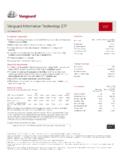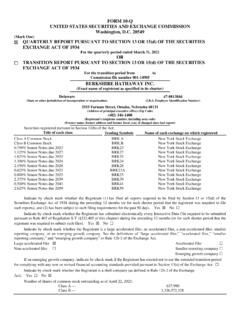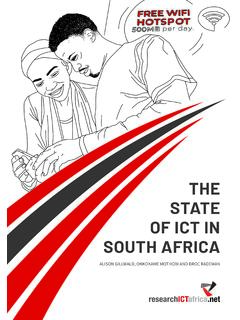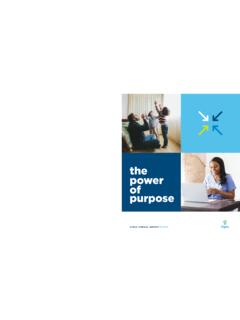Transcription of Agile and Project Portfolio Management (PPM) - Deloitte
1 Agile and Project Portfolio Management (PPM). This point of view covers What are common How do the What are key Agile Why is proactive misperceptions objectives of Agile features to align alignment a related to Agile ? and PPM relate? with PPM? strategic move? Common PPM misperceptions relating to Agile PPM is the art and science of gaining command over the work and resources in one's Project delivery organization. As depicted in the image below, the holistic, closed loop view of PPM feeds information to the Portfolio level from the three more tactical PPM practices: Demand Management , Project /Program Management , and Results Management .
2 Agile and Project Portfolio Management (PPM) 2. Portfolio Management Portfolio Resource Management Financial Management Governance Managers Result Management Resource Management Decisions Information Demand Management Project /Program Management Idea Idea Project Project Project Project Execution Initiation Closure Scope Cost Communication Time Quality Procurement Customers Resource Risk Integration Business or IT Program Project Managers Demand Management Project /Program Management Result Management Portfolio Management Receiving, evaluating, and Managing and controlling Managing.
3 Tracking, and Ongoing Management of deciding upon the execution Project progress, resource, reporting Project results the overall Portfolio . of work requests. risks, issues, nancials, scope, in comparison to the Constantly reassessing and quality approved business case. and improving processes. Source: Copyright 2015 Deloitte publication PPM! Manage Your Organization Masterfully with PPM. One common misperception of PPM is that PPM is a waterfall related methodology that needs to be theoretically modified before it can be associated with Agile .
4 Project /Program Management in the closed loop PPM diagram is not waterfall centric. The upper chevrons do not contain a Software Delivery Lifecycle methodology. Instead they show Project initiation, Project execution, and Project closure. All three of these activities relate to both Agile and waterfall projects. They also fall within the same sequence regardless of Project type. The attribute boxes below the chevrons (scope, cost, communication, time, quality, procurement, resource, risk, and integration) are all attributes common to all managed work, regardless of the delivery methodology.
5 Setting aside the misperceptions, the remainder of this document will focus on how an organization manages both waterfall and Agile projects/programs within the overall Portfolio using PPM. How do the objectives of Agile and PPM relate? Growth in Agile adoption: Business and Technology leaders are experiencing heightened market pressures for innovation and rapid delivery of new technology solutions. Continued pressures on the bottom line are causing CIOs to drive further optimization of their delivery functions. The confluence of these factors is leading many organizations to adopt Agile methodologies as a principal means to deliver solutions to customers, whether internal or external.
6 Agile blurs the lines between business and technology teams, puts decision making closer to the team doing the work, and favors continuous prioritization and delivery of working product. The rate of Agile adoption is accelerating, across a broad spectrum of industries and geographies. However, organizations may not be anticipating how Agile is integrated with their PPM function. The PPM framework: As stated in the previous section, the aim of PPM is to provide leaders with clear insights into the alignment, status, and resources to move their organization forward, and to make strategic adjustments as needed.
7 The essential PPM processes are Demand, Portfolio , Project /Program, and Results Management , and together, they provide the foundation for decision making and monitoring processes. Whether an organization employs primarily Waterfall methodologies, or has adopted Agile capabilities, the processes on the framework remain vital to achieving optimal outcomes. Agile and Project Portfolio Management (PPM) 3. However, as an organization begins to adopt Agile , teams may notice that Agile concepts, taxonomy, and measures are often different than their Waterfall counterparts.
8 We will highlight these differences, and discuss how to incorporate Agile and Waterfall delivery to manage a unified Portfolio . Organizations can gain the benefits of Agile delivery, while providing leaders with strategic insight into the Portfolio performance. What are key Agile features to align with PPM? Demand Management is focused on receiving, evaluating, and deciding upon work requests. This is accomplished with prescribed points of entry for new requests, and qualifiers to prioritize them. Agile introduces two key concepts that enhance demand Management , and support Portfolio and Results Management (defined later).
9 These new concepts are Value Streams and Epics. Value Streams are the ecosystem of teams that deliver against Epics. Epics are large cross-cutting initiatives that deliver solutions to the end user. As more teams adopt Agile across the organization, the need to define Value Streams and Epics is critical, to ensure coordinated planning and delivery. Incorporating these practices into Demand Management is essential for Agile teams to plan effectively. Portfolio Management is responsible for continually assessing the performance of active programs and projects, against defined criteria.
10 The focus is on governing the Portfolio to optimize resources, such that they are fulfilling the highest priorities of the organization. One way this is achieved is funding projects, which have a specific investment amount, a defined scope, and a target delivery date. At the macro level, traditional and Agile organizations will conduct Portfolio Management in the same manner. Even as an organization starts its journey to Agile adoption, there is really no difference in how the Portfolio is governed. However, organizations that achieve Agile at scale may fund Value Streams, allow de-centralized financial decision making within the Portfolio , and continuously prioritize their backlog of activities within each Agile Project to adjust to changing business priorities.
















